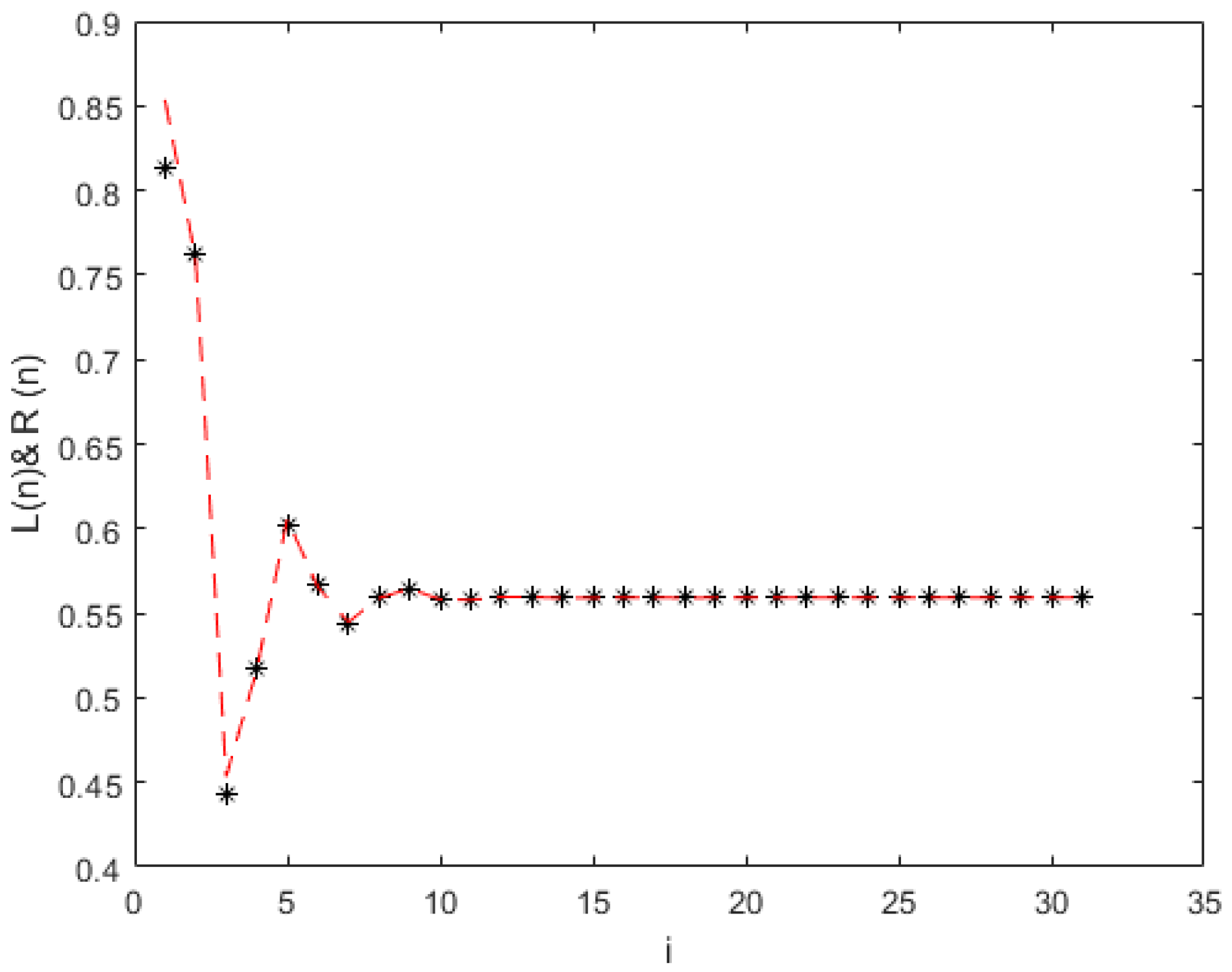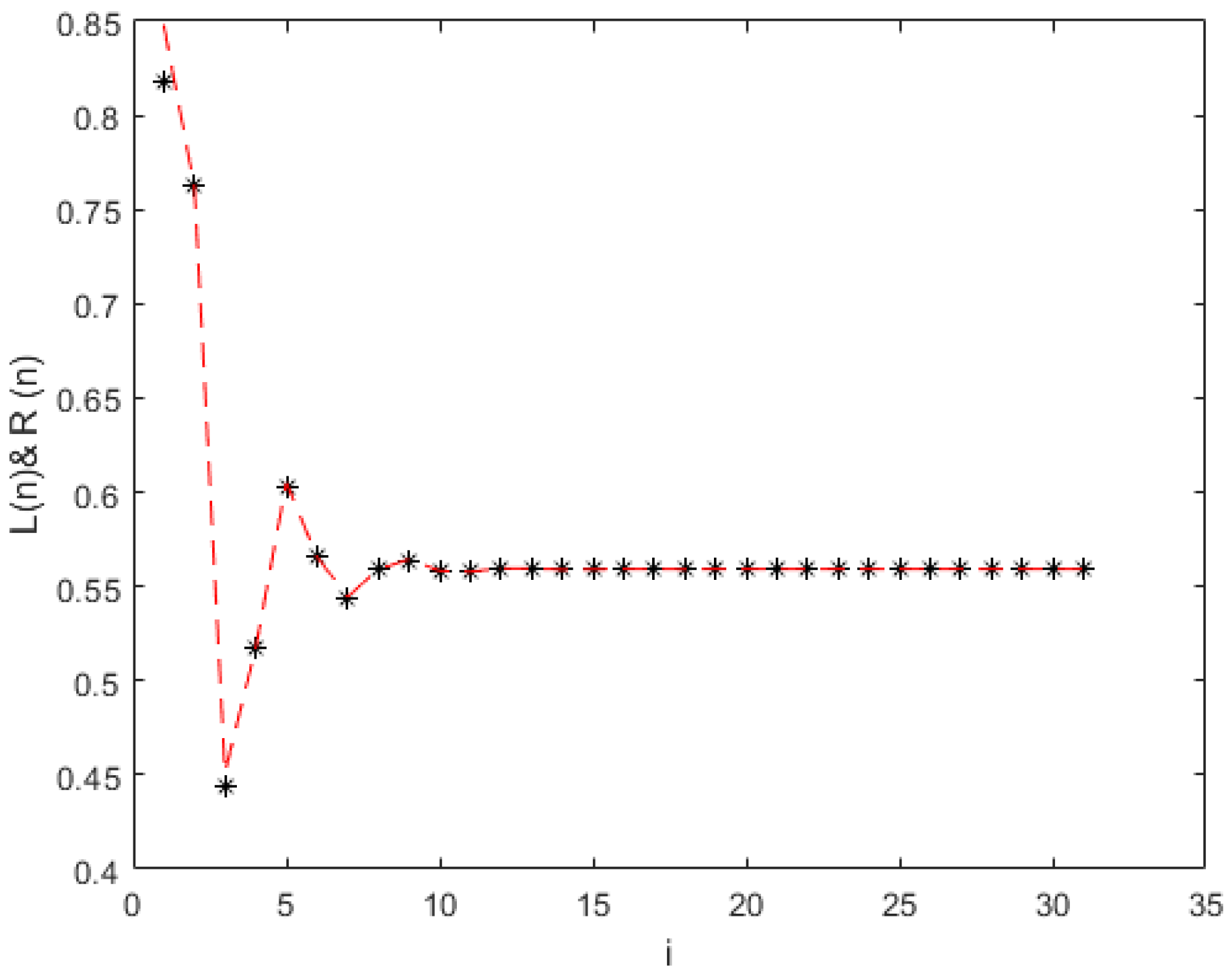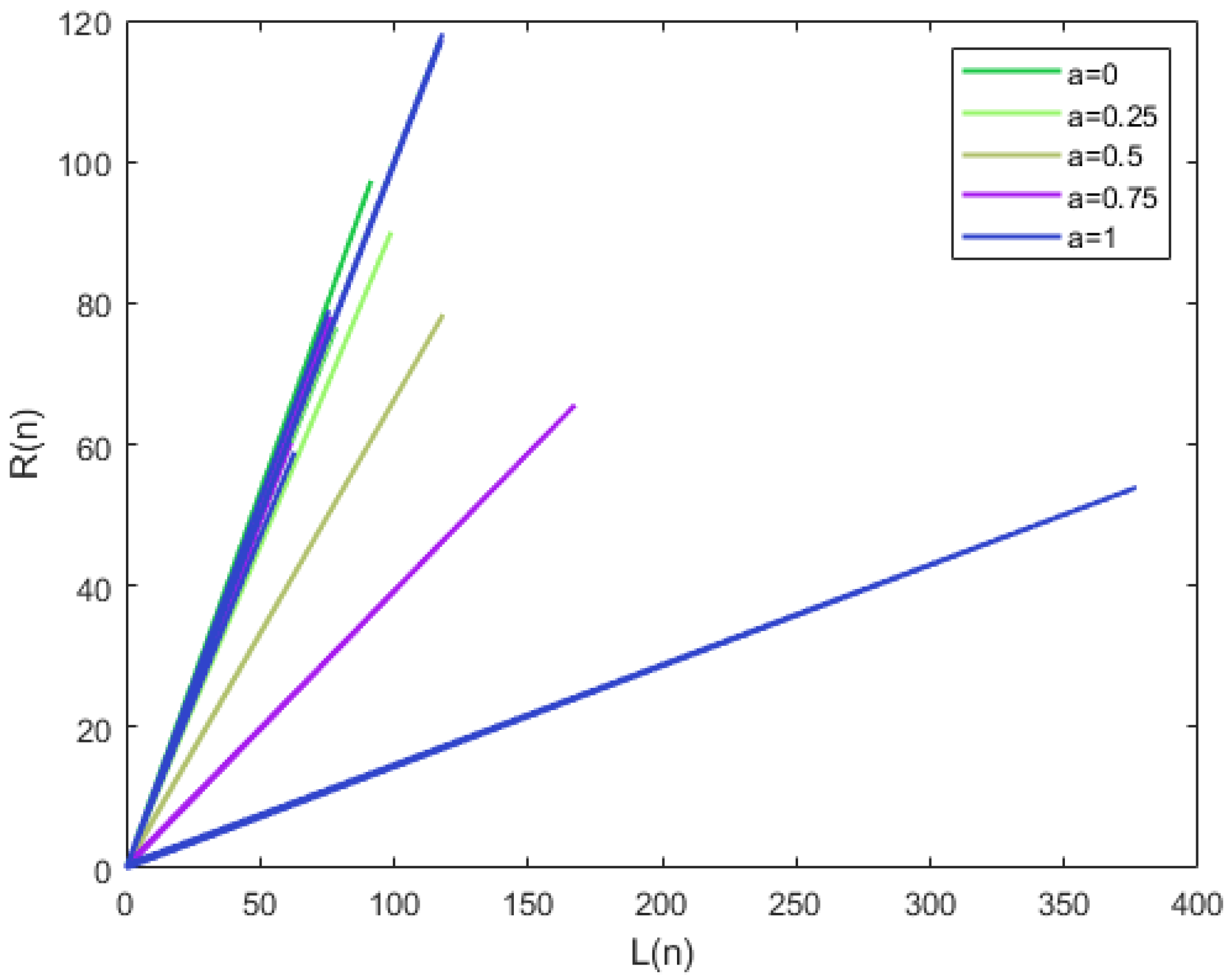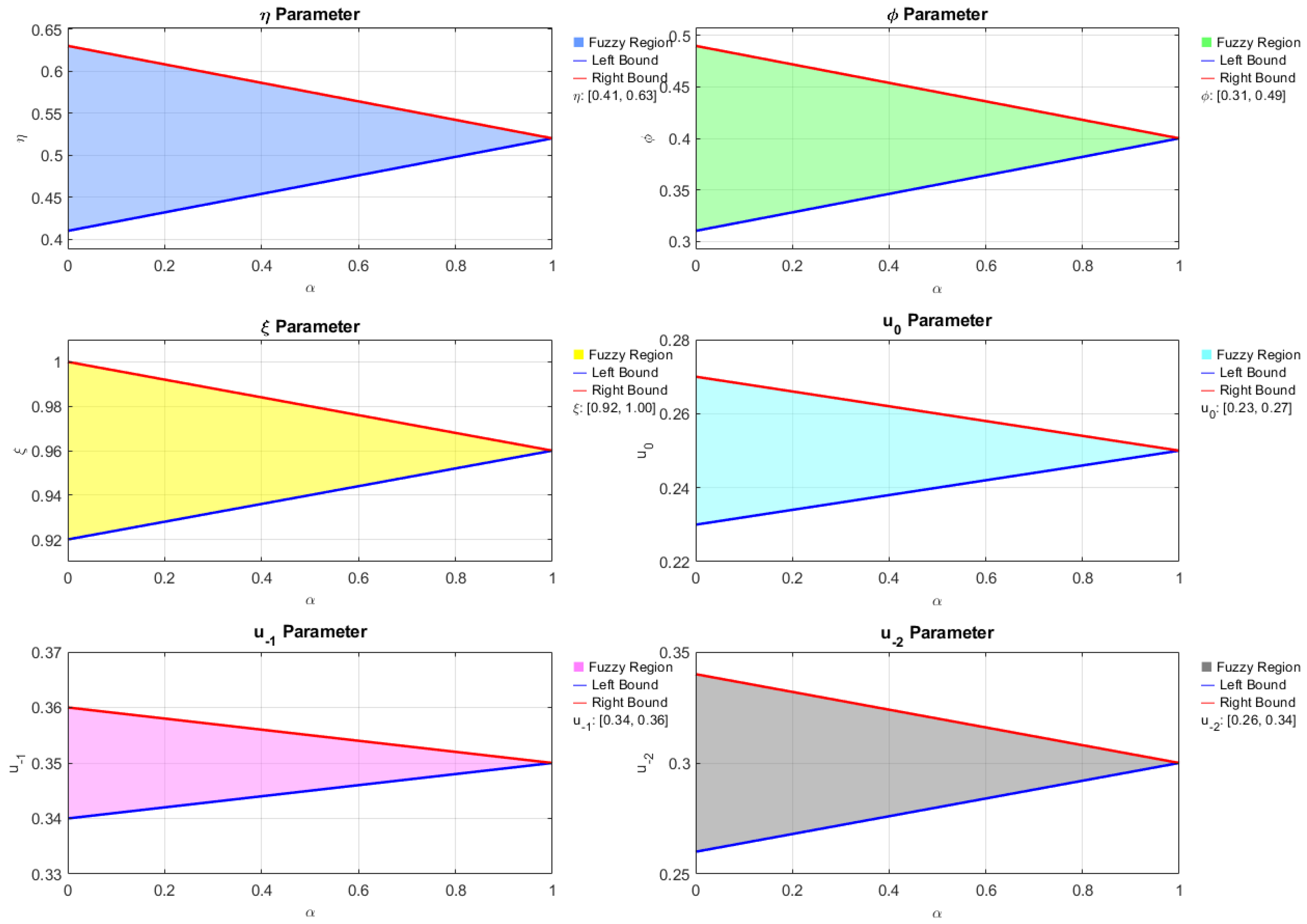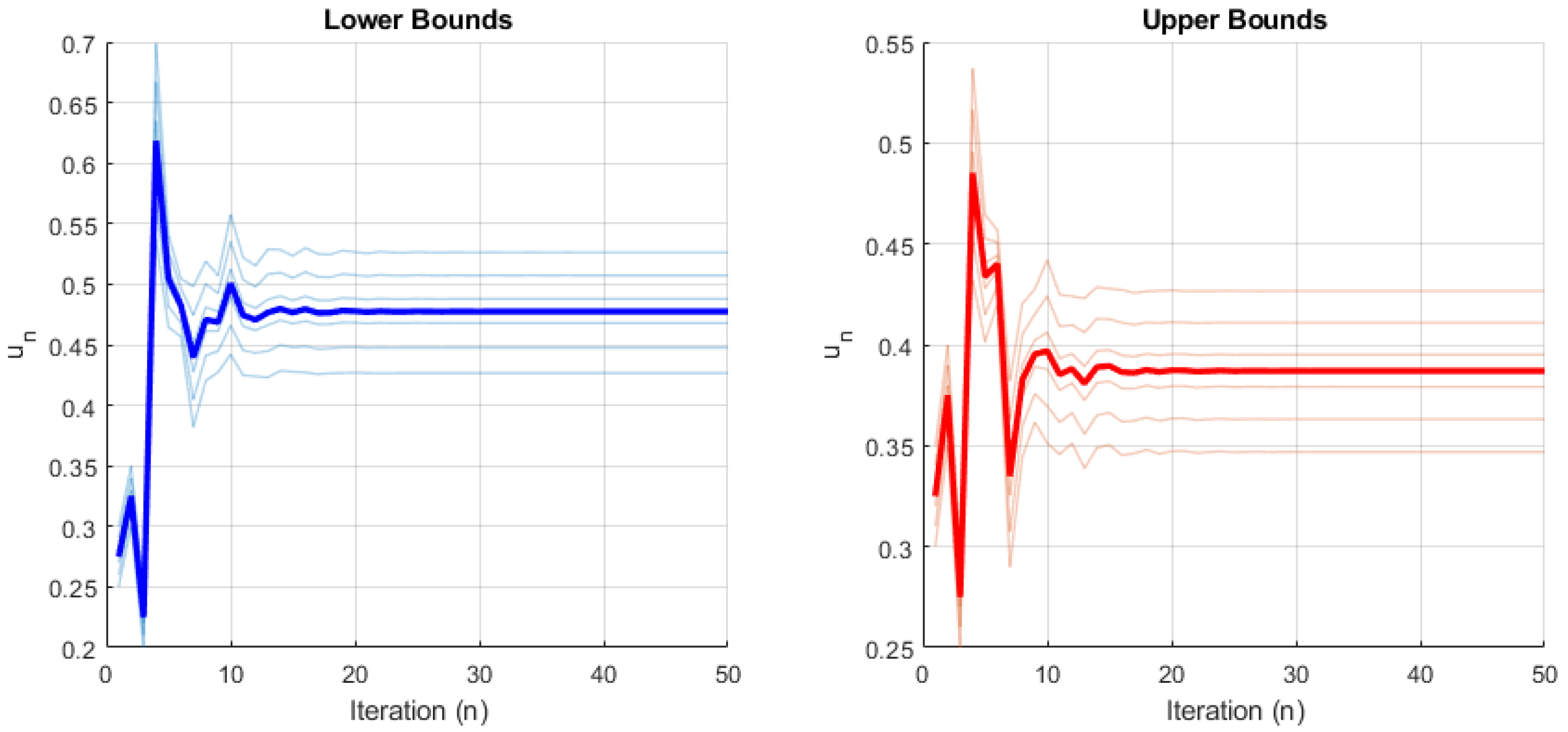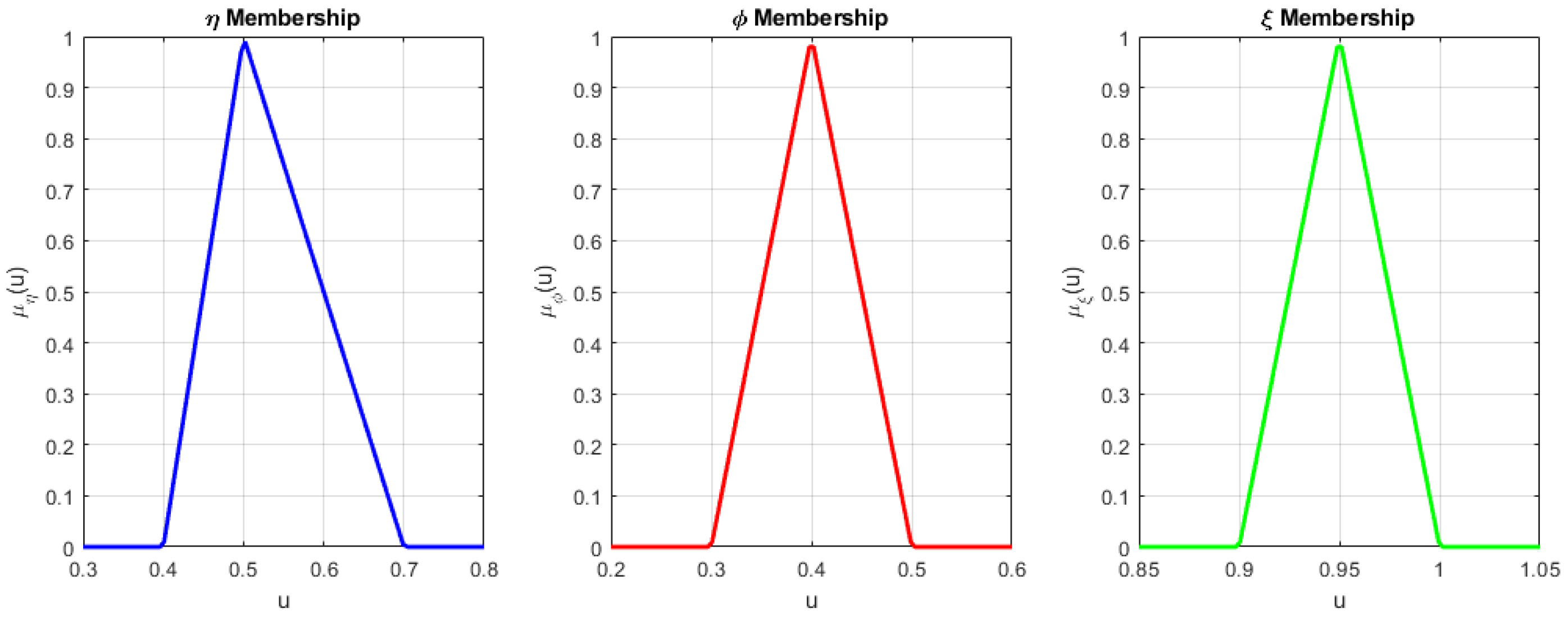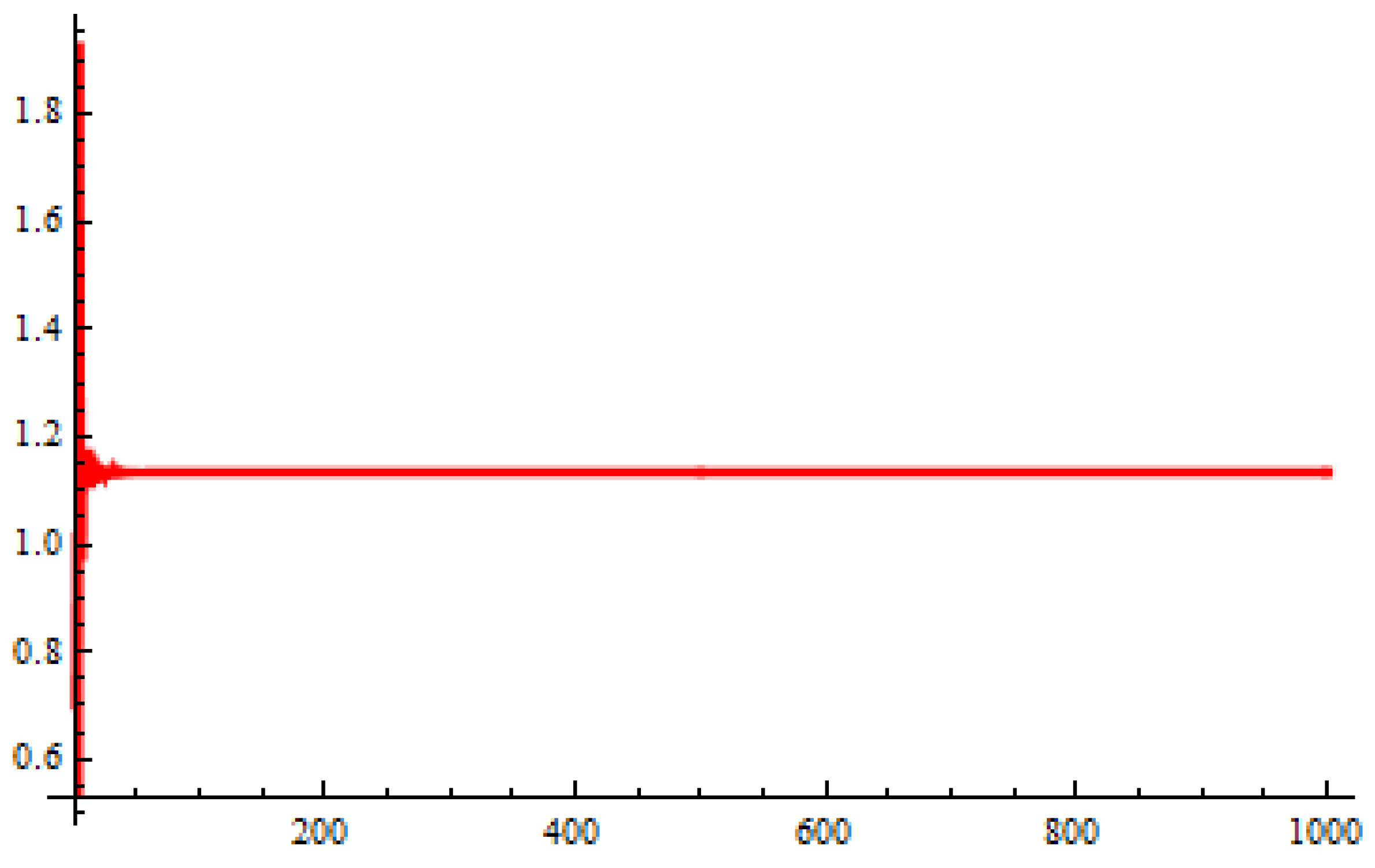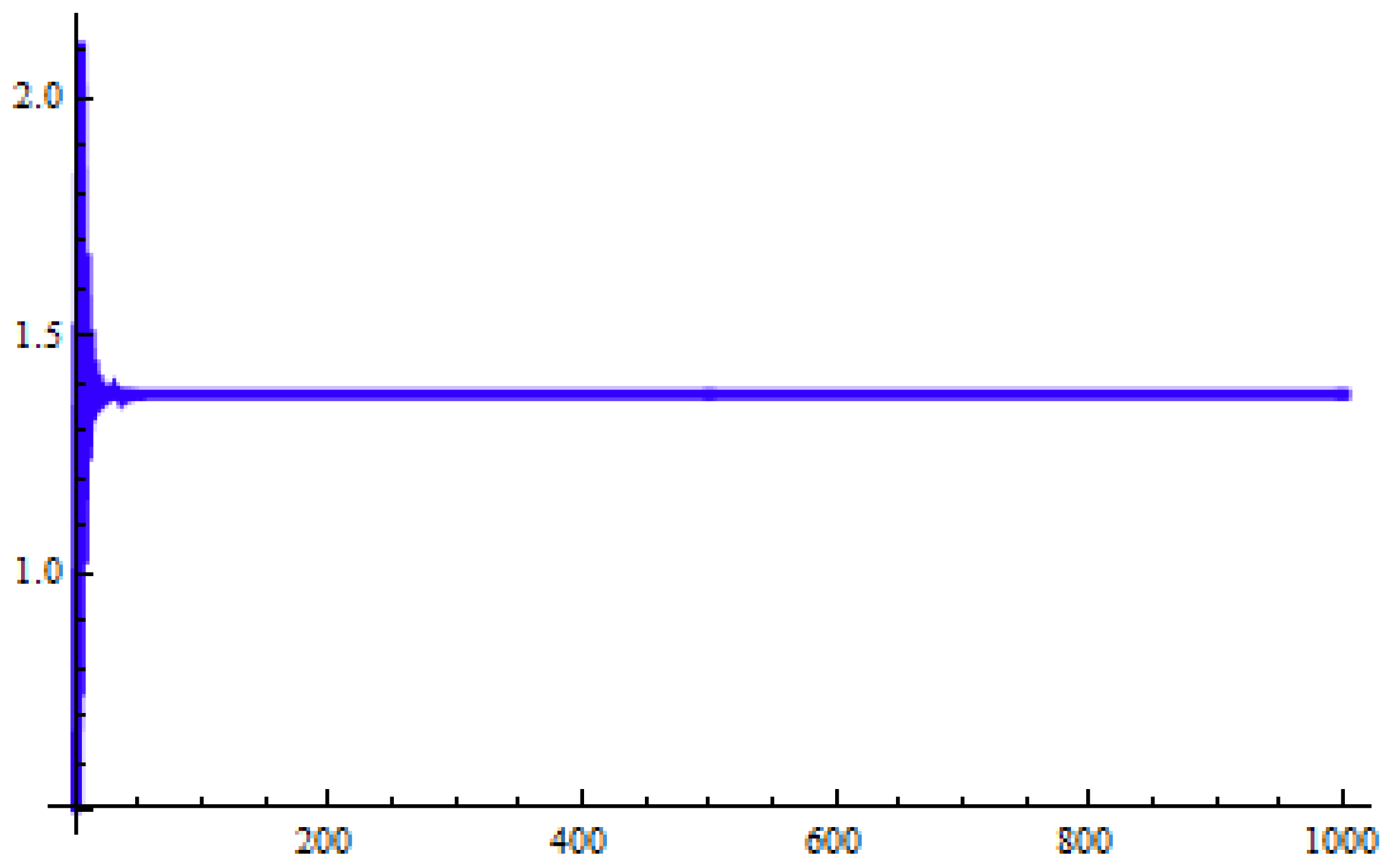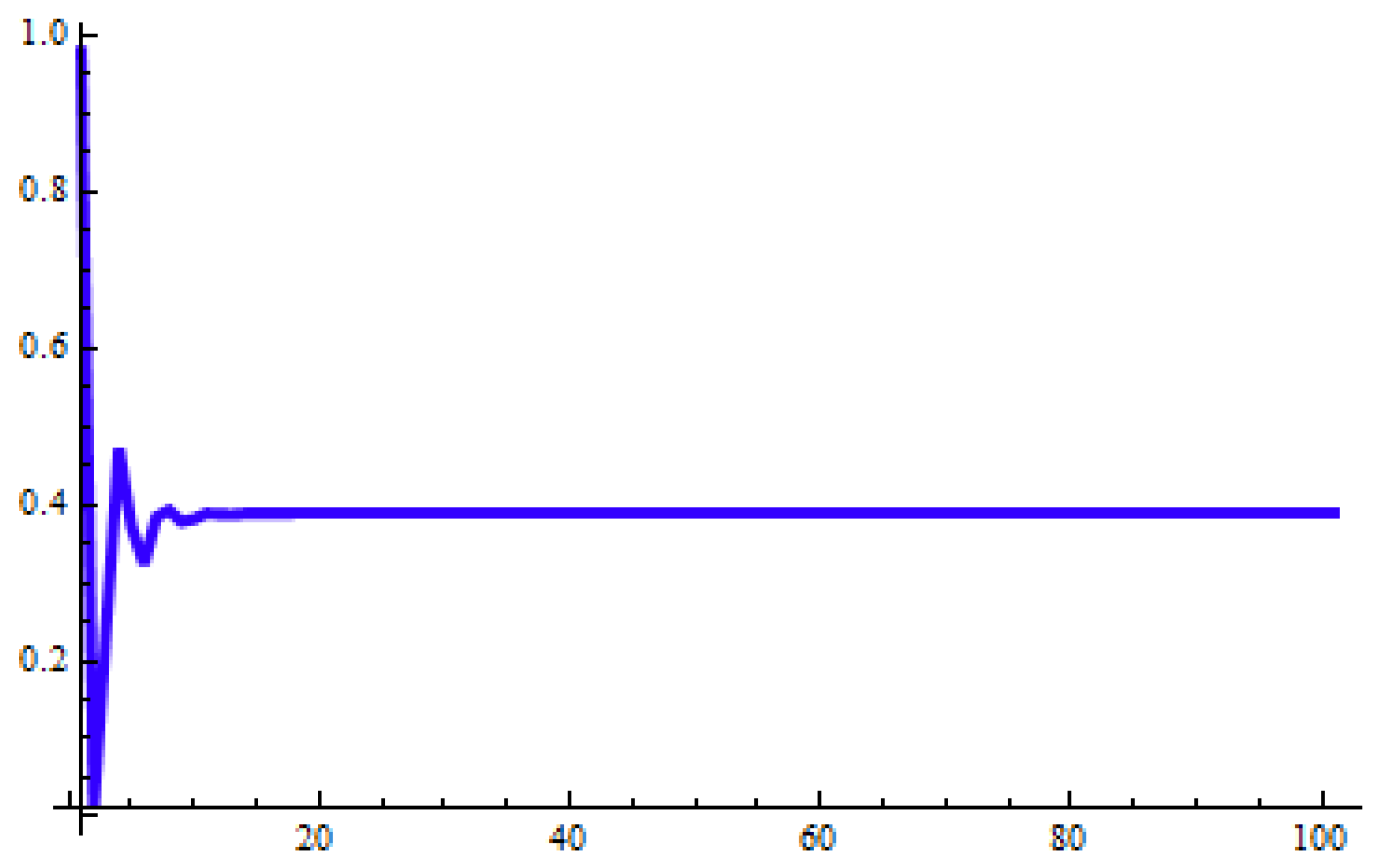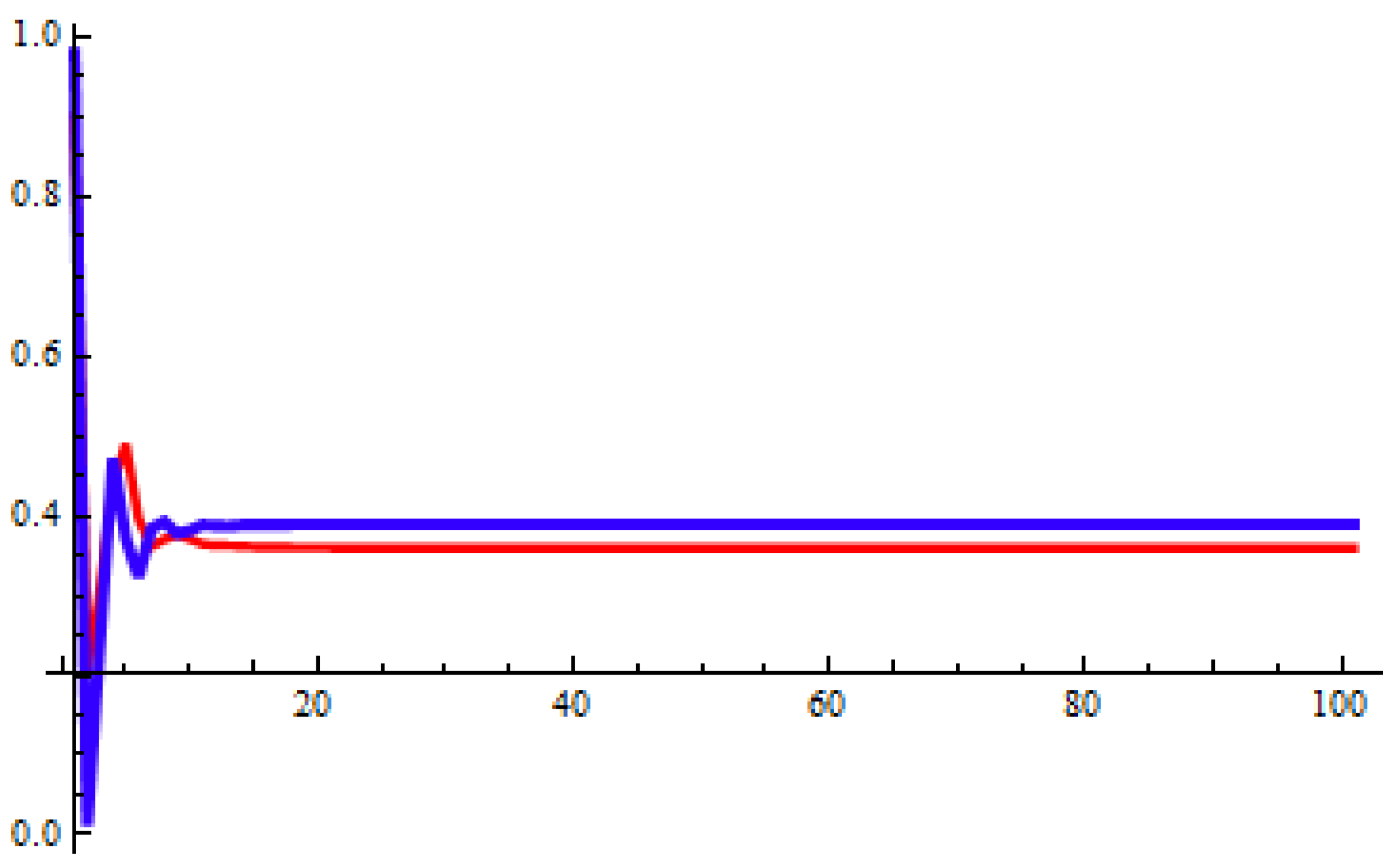1. Introduction
On the one hand, fuzzy difference equations provide a way to model uncertainty in discrete-time systems, and on the other, functional analysis offers tools for analyzing functions and operators. The two fields intersect when studying the behavior of solutions to fuzzy difference equations. Such solutions are described by fuzzy numbers or as a sequence of fuzzy numbers. Fuzzy numbers generalize classical real numbers to model uncertainty and imprecision and have transformed the way we represent and use data in a variety of sectors using fuzzy functional analysis [
1]. It is beneficial to express uncertain or ambiguous data quantitatively, which justifies the adoption of fuzzy difference equation frameworks. Within fuzzy set theory, imperfect or unclear data can be processed effectively, enabling fuzzy difference equations to represent dynamical systems with uncertain parameters. Fuzzy difference equations find extensive utility across various domains, such as automated control mechanisms, analytical procedures, and forecasting techniques. Integrating fuzzy set theory into system modeling allows for a more realistic representation of the inherent unpredictability and intricacy in practical scenarios. Furthermore, fuzzy difference equations prove particularly suitable for analyzing nonlinear and stochastic systems. These mathematical tools show significant promise in technical fields, economic studies, and financial modeling, where sophisticated systems are prevalent [
1]. The primary motivation for employing fuzzy difference equation models lies in improving the precision and reliability of system representations by accounting for real-world unpredictability and sophistication. In recent years, growing interest has emerged in both theoretical aspects and practical applications of fuzzy difference equations within applied mathematics. Taking motivation from these facts, we study the global dynamics and oscillatory behavior of nonlinear fuzzy difference equations with exponential decay in this research article. Therefore, we present the necessary review of the literature and related basic concepts in the subsequent paragraphs.
The concept of fuzzy difference equations was first introduced by Kandel and Byatt [
2]. Subsequent research by Zhang et al. [
3] examined the boundedness and persistence properties. A significant contribution to the field was Agarwal’s 1992 monograph [
4], which provided a comprehensive treatment of difference equations and related inequalities. Kocic and Ladas [
5] further advanced the field in 1993 by analyzing global behavior patterns in higher-order nonlinear difference equations. Over the years, considerable efforts have been made to analyze the qualitative behavior of nonlinear difference equations [
6], particularly in the context of biological and ecological systems [
7,
8]. Further advancements were presented in [
9], where Lyapunov functions were employed to examine the global stability of exponential difference systems. Meanwhile, Kalabušić et al. [
10] focused on a Leslie–Gower-type system of rational difference equations, providing a detailed analysis of its asymptotic behavior and attractivity. Other significant contributions include the study of nonlinear rational difference equations, such as those analyzed by Ozturk et al. [
11], where exponential terms and delays were shown to affect convergence and oscillatory behavior. Additionally, Touafek and Elsayed [
12] considered solution structures and boundedness in rational systems, enriching the theoretical framework. Collectively, these studies underline the importance and versatility of difference equations in modeling complex real-world phenomena [
13,
14]. Deeba and Korvin [
15] used a linearized version of the fuzzy difference equation to model
concentration in human blood. According to two mathematicians [
16], the positive results of fuzzy difference equations are unique, persistent, exist, and are bounded. An equation of second order was studied by Mondal et al. [
17] using the multiplier method. Based on Hukuhara’s difference as a tool for calculating fuzzy logic difference equations, Khastan [
18] derived a global solution. The principle of Zadeh extension was used in [
19] to study the global behavior of the fuzzy differential equation. Furthermore, the fuzzy difference equation
was investigated in [
20], where G is the non-negative fuzzy numbers and
. Stefanini [
17] introduced a new approach called g-division, a generalized method for dividing fuzzy numbers. Zhang et al. [
3] investigated the global dynamics of a third-order rational fuzzy difference equations using the g-partition of fuzzy numbers. Later, Khastan and Alijani [
19] also examined the same model. Notably, the solutions derived using the Zadeh principle exhibit a small diameter compared to those obtained by other researchers. Recently, g-division has become a widely applied technique in fuzzy differential equations, as evidenced in [
21,
22]. Zhang et al. [
3] studied non-zero results of finite difference equations. Ozturk et al. [
11] examined a second-order crisp difference equation of exponential type. A system of exponential-type difference equations derived from Din’s work [
7] revealed the existence and uniqueness of a positive equilibrium point and helped to understand the local and global behavior. Q. Zhang [
23] introduced the concept of the boundedness, convergence rate, and characteristics of non-negative exponential solutions of fuzzy difference equations of order two. Furthermore, Usman et al., in [
24], illustrated the concept of fuzzy difference equations of order two in a logarithmic environment. More recently, Tassaddiq et al. [
25] have proposed a Ricatti-type exponential fuzzy difference equation representing the global dynamics of the fourth order. Although their study provided foundational insights into the behavior of higher-order fuzzy systems, it primarily focused on fourth-order dynamics with delayed feedback.
Understanding the dynamics of nonlinear fuzzy difference equations is crucial for analyzing systems with inherent uncertainties. Fuzzy systems have been used to represent vague and imprecise knowledge across engineering, economics, and biological modeling. Recent developments in uncertain modeling, such as the theory of uncertain numbers [
26], and data-driven identification of dynamic systems through neural ODEs [
27], provide a foundation for improving fuzzy system formulations. The incorporation of exponential decay into fuzzy dynamics adds an additional layer of realism, accounting for memory effects and temporal fading, which are prevalent in physical and socio-economic processes.
Clustering and classification in high-dimensional fuzzy environments have also benefited from belief-based and imprecise modeling techniques [
28]. The study of collective dynamics using hypergraph-based Q-learning in multi-agent systems [
29], and their relevance in public goods and decision-making scenarios, illustrates the importance of capturing nonlinear interactions in fuzzy systems. Additionally, systems that involve both information and energy transfer, such as magnetron-based power architectures [
30] and grid-connected oscillation analysis [
31], underscore the need for robust models to predict long-term oscillatory behavior. Techniques for identifying systemic risks in nonlinear markets [
32], and polarization behaviors in complex media [
33], also contribute conceptual tools that may be extended to fuzzy difference frameworks.
Taking motivation from the above review of the literature, in this article, we consider the rational case, where the fuzzy difference equation involves a ratio of exponential functions, enabling a richer dynamical structure and allowing us to explore more complex convergence and stability behavior. To simplify the structure for broader applications, we reformulate the system as a third-order exponential rational fuzzy difference equation. This reduction in order not only enhances computational efficiency but also reveals rich dynamical properties relevant to real-world fuzzy systems with fewer time-lag dependencies. Expanding this line of inquiry, we investigate the behavioral characteristics of the third-order rational exponential fuzzy difference equation. In this work, we first investigate the positive solution, then we prove that the solution must be unique and persistent. The global behavior of solutions using the
g-division technique of fuzzy numbers is used. A key advantage of g-division is that it enhances the precision of fuzzy solutions by reducing the support length. This methodology enables the analysis of certain discrete-time dynamical systems taking fuzzy uncertainty into account. In this paper, we study the dynamic behavior of a nonlinear fuzzy difference equation of the form
where
is a sequence of fuzzy numbers, and
,
, and
are positive fuzzy parameters. The initial conditions are given by
,
, and
. Equation (
1) arises as a fuzzy extension of classical nonlinear difference equations and models systems in which uncertainty or vagueness in the parameters plays a significant role.
Fuzzy difference equations have been widely investigated in recent years due to their applications in control systems, population dynamics, and economics under uncertainty. Several works such as [
34,
35,
36] have addressed stability and boundedness properties in fuzzy discrete systems. However, most of these studies focus on either linear forms or specific bounded feedback structures. In contrast, the nonlinear and delayed structure of Equation (
1) presents unique challenges and has not been extensively explored in the existing literature.
The main goal of this paper is to analyze the boundedness, stability, and equilibrium behavior of solutions to Equation (
1). Our approach extends classical techniques in difference equations to the fuzzy context, providing new insights into the dynamics of such systems.
According to the plan of the paper,
Section 2 reviews fundamental concepts and existing theorems.
Section 3 establishes the existence and global behavior of solutions to the fuzzy difference Equation (
1), supported by key characterization theorems.
Section 4 validates the theoretical results through application to diverse forms of fuzzy numbers. Finally,
Section 5 summarizes the conclusions and discusses potential implications.
2. Preliminaries
This section reviews several fundamental definitions and results, mostly taken from [
37,
38,
39,
40]. Throughout this work, we denote the set of real numbers by
R.
Definition 1 ([
40])
. Fuzzy numbers are functions of satisfying the following conditions:Normality occurs when exists such that
is said to be a convex fuzzy number; if ∀ and , we have .
is semi-upper-continuous.
The support of , which would be used by , is compact.
The α-cut of fuzzy number , with , is defined by , in particular, we have .
Definition 2 ([
40])
. Fuzzy numbers can also be represented using two functions, and , where both functions map values from the interval to real numbers R. These functions describe the boundaries on both sides of the fuzzy numbers at different levels of certainty:The function is left-continuous and exhibits a monotonically increasing behavior.
The function is left-continuous, monotonically decreasing, and bounded in value.
For all , the inequality holds.
If a number satisfies for all , then the fuzzy number takes a degenerate form. The space of fuzzy numbers consists of all pairs with , forming a convex cone that is isometrically isomorphic to a Banach space [20]. Let denote the set of all fuzzy numbers on the real line . Each fuzzy number is characterized by its family of -level sets for , where and denote the left and right endpoints of the interval, respectively.
Definition 3 ([
40])
. For any , the metric distance is defined asThus, the pair constitutes a complete metric space.
Definition 4 ([
40])
. Let , for , and let . Then, iff and ;
;
;
Definition 5 ([
39])
. A triangular fuzzy number is characterized by the following membership function:The α-cut of is given byEach α-cut forms a closed interval. If , then is called a positive fuzzy number. This representation is particularly useful in applying the Stacking Theorem [40]. Theorem 1. Let be a convex family, nonempty, and the compact subset of R, satisfying
Then, there exists a fuzzy number such that
A novel division operation for fuzzy numbers, inspired by the gH-difference concept, was recently introduced by Stefanini [
37].
Definition 6 ([
37])
. For fuzzy numbers with α-cuts and , where for all , the generalized division (g-division) is defined by its α-cuts , satisfying- 1.
The inverse operation: .
- 2.
The division condition, , holds if either of the following hold:
- 3.
For to be a proper fuzzy number,
Let denote the set of all positive fuzzy numbers on , i.e., fuzzy numbers whose support is a subset of .
Remark 1. Let . If the fuzzy generalized division exists and , then according to [37], exactly one of the following cases holds: - Case I:
If for all , then - Case II:
If for all , then
We note that the fuzzy numbers considered in [34,35] are bounded and have persistent support. Definition 7. A sequence is called a positive fuzzy solution of (1) if it satisfies the equation. The equilibrium point of (1) is positive if there exists a positive fuzzy number satisfying (1). Definition 8. For a sequence of positive fuzzy numbers in , we say converges if .
Theorem 2 ([
36])
. (Characterization Theorem)Let denote the space of fuzzy numbers on . Consider the fuzzy difference equationwith initial value . Assume the mapping satisfies the following:
- (1)
The α-level representation of is given by - (2)
The functions and are continuous in their arguments. That is, for any , there exists such thatandwhenever
Then, the fuzzy Equation (1) is equivalent to the system of two real-valued difference equationssubject to the initial conditions 3. Uniqueness and Existence of System
We consider the fuzzy difference Equation (
1). Using the characterization theorem, the fuzzy difference equation can be transformed into an equivalent system of two crisp difference equations. This decomposition serves as the foundation for our analysis within the fuzzy theoretical framework. To investigate and establish the existence and uniqueness of positive solutions, we first present the following lemma.
Let denote the set of all positive fuzzy numbers on , i.e., fuzzy numbers whose support is contained in . Thus, .
Lemma 1 ([
40])
. Assume that h is the continuous operation, from , and the given and ξ are the fuzzy number. Then, Theorem 3. Consider Equation (1), where is a sequence of fuzzy numbers (fuzzy number), and let be positive constants. Assume the initial conditions are given. Then, there exists a unique non-zero solution to this equation corresponding to these initial conditions. Proof. The argument follows similarly to Theorem 3. Assume there exists a sequence of fuzzy numbers
that satisfies Equation (
1) under the initial conditions
. We now examine the
-level cut for
:
From Lemma 1, it follows that now we denote the left- and right-continuous functions by
and
:
According to Remark 1, we distinguish between the following two cases for further discussion:
Case II:
Considering Case I, we have
for all
and
. Now,
It is clear that for initial condition
, where
and
, the system (
8) has a unique solution of
. On the other hand we show that
, where
is the results of system (
8),
Putting
, and since
, and
are the positive fuzzy number and
, it is simple to see that
is the
-cut of
=
, for any
. Therefore,
Proceeding inductively, suppose that
are the
-cuts of
, i.e.,
. It remains to prove that
represents the
-cut of
.
According to Equation (
8), for any
, we obtain
As
represents the required
-level set of the fuzzy number
, where
it follows that for all
n and
, the interval
corresponds to the desired
-level set of the fuzzy number
.
Next, we aim to establish the uniqueness of this fuzzy solution. Assume that Equation (
1) admits a second solution sequence
that satisfies the same initial conditions for
. Then, following a similar line of reasoning as above, we have
for all
and for all
.
Hence, from Equations (
9) and (
10), it is evident that
If Case II holds, the argument mirrors that of Case I, and thus the proof proceeds analogously.
To analyze the global dynamics and oscillatory behavior of nonlinear fuzzy difference equations with exponential form (
1), we must first study the dynamics of their crisp counterpart. Thus, the result follows.
Following the g-division approach, we examine the two previously mentioned cases. When Case I holds, the subsequent definitions and lemmas are essential for proving the following theorems. □
Definition 9 ([
5])
. Consider the following system of difference equations:where () are positive real numbers and the initial conditions () are positive. A solution is called Lemma 2. Consider the system of difference equations defined in (14). Let the initial conditions be given by for . Assume the following two conditions hold: - 1.
The system defined by (14) admits a positive solution that is bounded. - 2.
The system possesses a positive equilibrium point , which is locally asymptotically stable, provided thatand
Proof. To proceed, (i) let
be the positive result of (
14), then we have
Now from (
14) and (
17), we have
From (
17) and (
18) we have
This implies that the positive result of (
14) has a bounded existence. (ii) Now, let us examine the systems
This means that we are now able to write (
19) as follows:
From the required system (
20), we have
and also we denote this as
Now, we obtain
and
Therefore, our analysis confirms the existence of at least one positive solution
w satisfying
.
By examining Equations (
15) and (
21), we obtain
Therefore, the equation
admits a unique positive equilibrium point
. Similarly, there exists a unique positive equilibrium
.
Moreover, the Jacobian matrix
of system (
1), evaluated at
, is given by
where
,
,
,
,
,
.
We now derive the characteristic equation of the Jacobian matrix
evaluated at the equilibrium point
, which is given by
To find the characteristic equation we take absolute values of
, i.e,
By Remark 1 of [
5], we conclude that
is asymptotically stable. □
Lemma 3. The equilibrium point of (14) is said to be globally stable if Proof. .
Since
for all
, then we have
. Moreover, we conclude that
Now, we take the difference
:
Under condition (3), for any
, we have
This implies that and . Thus we conclude that .
When we used condition (ii) of Lemma 2, we proved that is globally stable. □
Theorem 4. Consider the fuzzy difference equation of (1):Then, two conditions hold: - (i)
Every positive solution of (1) exists and is bounded. - (ii)
Every positive solution of (1) converges to a unique equilibrium point v as , and for all
Proof.
(i) Since
, there exist positive numbers
such that
Let
be a positive solution of (
1). Using (
28), (
31), and Lemma 2, we get
This shows that
is bounded and persistent.
For (ii), consider
From this,
Let
. From (
28),
Based on Conditions (
29) and (
30), and by applying Lemmas 2 and 3, it follows that Equation (
35) possesses a unique equilibrium point
given by
From (
32) and (
34), for
,
The left-continuity of the coefficients implies left-continuity of
. Moreover,
Thus
is compact. There exists
satisfying
Uniqueness follows similarly. Finally,
proving global convergence to the unique equilibrium point
v. □
Lemma 4. Consider the following system of difference equations:with the initial condition and . Then, the following two conditions hold: - (i)
All trajectories of (41) remain bounded and the system is persistent. - (ii)
The systems of (41) must have a unique positive equilibrium point.
Proof.
(i) From (
41) it is clear that
By (
41) and (
44), we have
Now, from Equations (
44) and (
45) we see that Equation (
10) is persistent and bounded, i.e.,
(ii) implies that we consider
Equation (
46) can also be written as
Now, from (
47) we have
where
We have
From (
48) and (
49), we have
Now, let
be the solution of
; then we have, from (
47) and (
51),
where
By putting (
51)–(
53) into Equation (
50), then we have
To continue (
42) by putting in the value of
, we get
Therefore,
F(
w) = 0 is the unique equilibrium point, i.e.,
The component
can also be obtained by similar arguments. This completes the proof (ii). □
Lemma 5. The positive equilibrium point of of (41) is locally asymptotically stable if Proof. Let
be the unique equilibrium point of (
41). Then, the Jacobian matrix
of (
41) is given by
where
; ; ;
; ; .
The characteristic equation of
at
is given by
since condition (
56) holds, i.e.,
where
.
By substituting in the values of
, we get
From (
58) we conclude that the absolute value of each eigenvalue of (
57) satisfies
. Hence,
is locally asymptotically stable. □
Theorem 5. Consider a fuzzy difference Equation (
1).
Ifthen the following results hold: - (i)
Each positive solution of (
1)
exists and is bounded. - (ii)
Equation (
1)
converges to a unique positive equilibrium point z as , and if , then
Proof. Condition (i) is similar to one of the earlier assertions in Theorem (
28). Assume
is the positive solution of (
1). Then, from (
1), (
59), and Lemma 5, we get
Hence, the interval
is bounded and exists.
(ii) The proof proceeds in the same way as in Theorem (
28). □
5. Conclusions
Mathematical modeling serves as a fundamental tool in disciplines such as engineering, ecology, and social sciences for addressing complex real-world problems. While difference equations are effective in representing continuous phenomena, difference equations are more suited to discrete systems. Recently, the use of difference equations in modeling discrete systems has gained significant attention. When uncertainty and vagueness are inherent in these problems, fuzzy set theory becomes a natural extension in the study of difference equations. The field of fuzzy difference equations has already yielded various insightful findings and continues to evolve.
This article focuses on solving a linear fuzzy difference equation characterized by initial conditions which are fuzzy, fuzzy numbers, and fuzzy parameters. Our work further investigates the equilibrium states and their stability in a system modeled by a fuzzy difference equation. The key contributions of this research can be summarized as follows.
Global dynamics and oscillatory behavior of nonlinear fuzzy difference equations with exponential decay are examined using the g-division approach. The existence of positive solutions for Equation (
1) is established through qualitative analysis.
- (i)
According to Case I, it is shown that Equation (
1) admits a bounded and positive fuzzy solution. Additionally, based on Equations (
29) and (
30), every positive solution
can be found to terminate at a unique equilibrium point
for any number
.
- (ii)
Similarly, a bounded positive fuzzy solution is guaranteed in Case II. Furthermore, if Conditions (
60) and (
61) hold, then every positive solution
tends to a unique equilibrium point
as
.
The theoretical findings are supported through two numerical simulations. The numerical results validate the theoretical predictions and demonstrate convergence behavior effectively. The results enhance our understanding of fuzzy difference equation-based models in the context of population dynamics and economic systems. For future work, the exploration of fuzzy population dynamics is suggested. Additionally, further qualitative studies—such as investigating invariant intervals and performing bifurcation analysis—may yield deeper insights into the behavior of the given model. Future extensions of this work may explore fractional-order fuzzy difference equations that incorporate memory kernels and long-range dependencies, building upon approaches such as the octonion linear canonical transform [
41] and energy-adaptive synchronization of nonlinear neuron models [
42]. Integrating fuzzy difference equations with predictive control strategies, such as those driven by kernel-based Lipschitz regression and clustering [
43], could enable real-time adaptation in cyber–physical systems.
Moreover, there is potential for applying fuzzy frameworks in the study of low-frequency oscillations in large-scale power networks, particularly those utilizing virtual synchronous generators [
44]. Leveraging uncertainty-invariance principles and granular-ball rough set models [
45] can enhance decision making in fuzzy environments, especially in systems with dynamic thresholds. Finally, incorporating fast and adaptive clustering techniques based on self-growth maps [
46] could significantly improve computational modeling of streaming fuzzy data and real-time feedback-driven systems.
